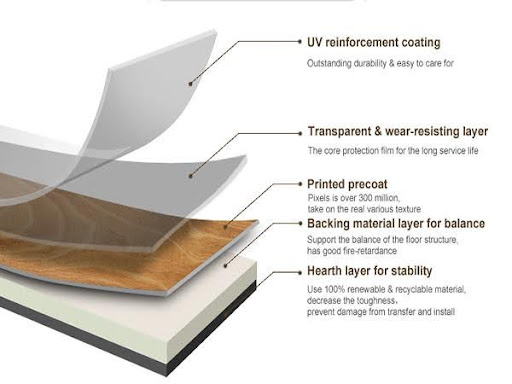To sign up for our daily email newsletter, CLICK HERE
Most families prioritize flooring that is easy to clean, ensuring convenience in daily maintenance. Moreover, longevity is high on their list, alongside flooring that enhances the overall appearance of their living spaces. When people consider these factors, they come across two major choices: LVT flooring tile and ceramic tiles. Keep reading for more information on why LVT floor emerges as the new star in indoor decoration and what’s the differences between the conventional and the new.

LVT & Ceramic: A Comparison
Luxury Vinyl Tile (LVT) is an innovative flooring option known for its versatility. Composed of multi-layered PVC, LVT flooring tile replicates the look of natural materials like wood or stone while offering superior durability. Its easy installation and low maintenance make it a popular choice for families seeking a balance between aesthetics and practicality.
On the other hand, ceramic tiles are crafted from clay and other minerals, providing an elegant flooring solution. Known for their durability and resistance to moisture, ceramic tiles are ideal for high-traffic areas and spaces prone to spills.
The most important consideration in flooring is always water resistance. Thankfully, LVT flooring tiles are completely waterproof if installed correctly. Therefore, you can use them in moist places, such as kitchens, bathrooms, etc. However, gaps between the planks can lead to a build of moisture and eventually mildew or mold.
Similarly, LVT flooring tiles exhibit impressive resistance to wear, making them durable in busy spots. Their protective wear layer shields against scratches and abrasions. Similarly, vinyl flooring is resistant to flames so that it won’t aid the spread of fire in an emergency.
Ceramic tiles generally have a lower water absorption rate. However, unlike vinyl tiles, which offer enhanced moisture resistance, ceramic tiles may require sealants to maintain their water resistance. Additionally, while ceramic tiles withstand moderate heat, they are more prone to cracking under extreme temperature changes compared to the heat resilience of vinyl tiles.
There is no shortage of colors and designs in LVT flooring tiles, allowing people to have the flooring they like. Usually, they mimic hardwood floors and come in distressed hickory, barn wood oak, and more styles. Similarly, they also come in various sizes, with their width ranging from 6-9 inches and length from 36-72 inches.
Ceramic tiles are also available in multiple colors and shapes but cost more. If you want variety in ceramic tiles, you should go for porcelain.
The eco-friendliness of ceramics is beyond question. However, people will question LVT flooring tiles. As the flooring material market gets bulkier, the restrictions and certifications are getting stricter, especially in this way. Currently, more and more LVT flooring tile manufacturers select heavy-metal-free and non-toxic base materials for production, which have adopted EU certification.

Copyright picture from https://www.3c-floor.com/m/newsdetail.asp?id=260
The Structure of LVT Flooring
LVT flooring tiles come with different layers for their resistance to various matters:
- UV coating for better appearance and longer lifespan. The green coating that comes with an airy texture can protect the tile from scratching, which will extend its lifespan.
- The transparent wear-resistant layer is made of high-quality polymer resin material, which is colorless and odorless. It comes with an ultra-high wear resistance rate, which is 20 times that of laminate flooring, with good transparency and strong adhesion. It not only meets environmental protection standards but also highlights the quality of the film more clearly.
- The printed fabric layer employs advanced digital imaging technology, scanning the natural texture of wood with ultra-microscopic precision of 1/1000 millimeters. The pixel count is as high as 30 million, 10 times that of a professional camera.
- The balance layer of the substrate uses non-toxic, first-hand materials.
- The pressure-resistant stable layer is entirely free of formaldehyde, ensuring environmental safety. The glue-free product has a special design, providing a firm grip on the ground.
Boyu LVT Flooring – a Perfect Choice
Getting the highest quality machinery to produce tiles to last a long time is essential. The Boyu LVT Flooring line is the best choice, a certified twin screw extruder machine. It is precise in its operation and produces high-quality tiles.
With a touch screen control made by Omron or Siemens, operators can use it easily and navigate different options. Similarly, the electric equipment and buttons are from Schneider, a renowned brand.

Conclusion
As the above discussion clarifies, LVT flooring tiles have a clear advantage over ceramic tiles with better durability, looks, and positive environmental impact. However, it’s also crucial to manufacture them correctly using state-of-the-art machinery from Boyu.
Established in 1998, they are considered one of the leading extrusion machine manufacturers. With more than 90 patents and the integration of everything from design to sales & after-sales, Boyu can be your trustworthy partner for flooring manufacturing.